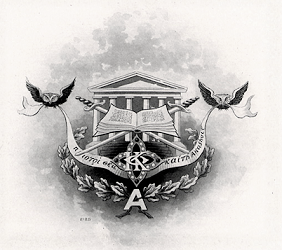
Sigma Delta Tau (ΣΔΤ) is an American sorority and member of the National Panhellenic Conference. Sigma Delta Tau was founded on March 25, 1917 at Cornell University by Jewish women. However, there is no religious requirement for membership to the sorority, and it prides itself on being inclusive of all, as well as being historically Jewish. Sigma Delta Tau has over 70,000 initiates from 105 chapters around the United States.
While most of the traditional women's fraternities or sororities were founded decades before the start of the 20th century, the first ever specifically Christian-themed Greek Letter Organization formed was the Kappa Phi Club, founded in Kansas in 1916. Kappa Phi was a women's sisterhood that developed out of a bible study and remains one of the largest nationally present Christian women's collegiate clubs today. Later organizations added more defined social programming along with a Christian emphasis, bridging the gap between non-secular traditional sororities and church-sponsored bible study groups, campus ministries and sect-based clubs and study groups.

Lambda Omega (ΛΩ) was a national collegiate sorority operating in the United States from October 31, 1915 until 1933.
The North American fraternity and sorority system began with students who wanted to meet secretly, usually for discussions and debates not thought appropriate by the faculty of their schools. Today they are used as social, professional, and honorary groups that promote varied combinations of community service, leadership, and academic achievement.

Iota Alpha Pi (ΙΑΠ) was an international collegiate sorority operating in the United States and Canada from March 3, 1903, to July 1971, when it ceased operations. It was then restarted when Alpha chapter was rechartered at Hunter College in October 2023. As of November 2024, the Alpha chapter has been suspended by Hunter College.
This article describes smaller collegiate sororities created in the nineteenth century and early to middle twentieth century on campuses in the United States and Canada. These sororities are defunct. Individual chapters may have affiliated with National Panhellenic Conference (NPC) sororities.

Beta Phi Alpha (ΒΦΑ) was a national collegiate sorority operating under that name in the United States from 1919 until 1941. It was absorbed by Delta Zeta sorority.

Delta Sigma Epsilon (ΔΣΕ) was a national collegiate social sorority founded at Miami University, operating in the United States from 1914 to 1956. It was originally a member of the Association of Education Sororities (AES) before the AES's merger with the National Panhellenic Conference, and most of its chapters were located at teaching colleges. The sorority was absorbed by Delta Zeta sorority on August 21, 1956.
Phi Omega Pi (ΦΩΠ) was a national collegiate sorority operating in the United States from 1922 until 1946 when its chapters were absorbed by several larger sororities, and merged with the national sorority, Delta Zeta.

Alpha Kappa Pi (ΑΚΠ) was an American collegiate social fraternity founded in 1921 at the Newark College of Engineering. In 1946, it merged with Alpha Sigma Phi.

Fraternities and sororities at the University of Virginia include the collegiate organizations on the grounds of the University of Virginia in Charlottesville, Virginia. First founded in the 1850s with the establishment of several fraternities, the system has since expanded to include sororities, professional organizations, service fraternities, honor fraternities, and cultural organizations. Fraternities and sororities have been significant to the history of the University of Virginia, including the founding of two national fraternities Kappa Sigma (ΚΣ) and Pi Kappa Alpha (ΠΚΑ).

Theta Sigma Upsilon (ΘΣΥ) was an American sorority founded on March 25, 1921 at Emporia State University. It chartered 23 chapters in the United States. The sorority merged with Alpha Gamma Delta on June 29, 1959.

Phi Kappa (ΦΚ) was an American social fraternity founded on October 1, 1889 by a group of Catholic students at Brown University who were refused entrance to other fraternities because of their faith. On April 29, 1959, Phi Kappa merged with a similar fraternity Theta Kappa Phi to form Phi Kappa Theta.

Kappa Nu (ΚΝ) was an American college fraternity that was active from 1911 to 1961 when it merged with Phi Epsilon Pi.

Phi Sigma Delta (ΦΣΔ), colloquially known as Phi Sig, was an American collegiate fraternity established in 1909 with a predominantly Jewish membership at Columbia University. It eventually opened at least more than sixty chapters. Phi Sigma Delta merged with Zeta Beta Tau in 1970, retiring its original name.

Sigma Delta Rho (ΣΔΡ) was a small American's men's fraternity founded on January 8, 1921 at Miami University of Ohio, the fifth general social fraternity to be formed at that school. It "disintegrated" in the spring of 1935 due to pressures of the Great Depression and "absence of strong leadership." About half its chapters were absorbed into other fraternities.

Omicron Alpha Tau (ΟΑΤ) was an historically Jewish fraternity founded in 1912. It merged with Tau Delta Phi in 1934.

Sigma Tau Phi (ΣΤΦ) was a historically Jewish fraternity founded in 1918 and which merged into Alpha Epsilon Pi (ΑΕΠ) in 1947.















